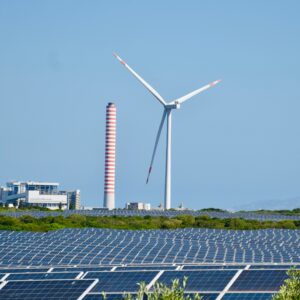DOI Proposes Increase of Renewable Energy Rents and Fees on BLM Lands
May 14, 2025
On May 14, 2025, the Department of the Interior (DOI) issued a press release signaling its intent to significantly increase annual rents and fees for renewable energy projects on federal lands by rescinding the Bureau of Land Management’s (BLM) Renewable Energy Rule that took effect in July 2024.
The recission also would remove certain elements of BLM’s application processing regulations and may reinstate the framework in place under BLM’s old regulations that had been in effect since 2017. The following assessment summarizes the current state of BLM’s renewable energy regulations and what could happen next, with a focus on annual rents and fees for new and existing renewable energy projects.
The current regulations under the 2024 Renewable Energy Rule charge wind and solar rights-of-way (ROW) the greater of either acreage rent based on statewide pastureland cash rent data compiled by the National Agricultural Statistics Service (NASS), or capacity fees based on an eight-factor formula tethered to energy prices as of the year of ROW issuance. In practice, that means ROW grantees pay acreage rent during project construction, and capacity fees during project operation. The rent and fee framework applies to all new ROW grants issued after July 1, 2024, and all preexisting ROW grants that opt in before July 1, 2026. BLM framed the Renewable Energy Rule as a discount relative to the fair market rent value of federal lands pursuant to its discretion to lower rates under the Energy Act of 2020, and in general charges are lower for most projects under the current rule than they were under the previous framework. Please see our firm’s article on the Renewable Energy Rule here for more details.
If DOI rescinds the Renewable Energy Rule as signaled in its press release, one possible scenario is a reversion to the preexisting rent and fee framework set forth in BLM Manual MS 2806 published in June 2022. This “interim guidance” charged both acreage rent based on statewide, non-irrigated land rental values compiled by NASS, and capacity fees of $2,000 per nameplate megawatt (MW). The guidance lowered rent relative to the regulations that had been in effect in 2022, and (like the Renewable Energy Rule) was presented as an exercise of BLM’s discretion to lower rates below fair market value. However, given DOI’s intent to end so-called “preferential treatment” of renewable energy on federal public lands, it is likely BLM also will rescind the interim guidance for the same reason once policymakers realize it is the next rent and fee backstop.
If BLM rescinds the interim guidance as expected, the next rent and fee backstop would be the previous regulations themselves. The rent and fee framework in the previous regulations (which were in effect from 2017 until last year) charged both acreage rent by placing counties in “zones” based on NASS data for irrigated cropland rental values, and capacity fees based on rolling 5-year average energy prices. The rates were published in 5-year schedules, the most recent of which ends in 2025. Rents and fees under the old regulations were untenable in many cases, which spurred industry challenges and responsive action by the Biden administration to offer the 2022 interim rent relief and, ultimately, the new 2024 regulations that are now under threat of rescission.
An alternative to defaulting to the 2017 rule as a result of the Renewable Energy Rule’s rescission could be a new renewable energy rent and fee framework proposed in the House Committee on Natural Resources draft budget reconciliation language released on May 1, 2025. Under that language, projects under construction would be charged acreage rent similar to that provided in the Renewable Energy Rule based on pastureland rent values compiled by NASS, and operational projects would be charged a capacity fee equal to “4.58 percent of the gross proceeds from the sale of electricity produced by the renewable energy project.” The rates under this formula would vastly exceed even those under BLM’s previous regulations. In addition, the proposed legislation would eliminate the Energy Act of 2020’s provision authorizing BLM to lower renewable energy rents and fees below fair market value. Please see our firm’s article on the proposed legislation here for more details.
Even if the reconciliation bill does not pass into law, it is possible BLM could seek to replace the Renewable Energy Rule with the same framework as the reconciliation bill or some other entirely new set of rent and fee formulas rathe than simply defaulting to the 2017 rule.
What comes next after DOI rescinds the Renewable Energy Rule depends on the official action taken by the Office of Information and Regulatory Affairs to roll back the existing regulations. A BLM spokesperson has told journalists there will be a public comment period, which will provide industry with an opportunity to engage in the rulemaking process.
Regardless of the framework that replaces the Renewable Energy Rule, the cornerstone of BLM’s rent policy is the Federal Land Policy and Management Act’s (FLPMA) directive that the agency charge “fair market value” for use of federal lands. Simply put, BLM’s charges cannot exceed fair market value. (Nor could they fall short of fair market value until the Energy Act of 2020 granted them the discretion.) A reversion to the old rent and fee framework would purportedly be a return to fair market value, but in reality charges likely would exceed fair market value in violation of FLPMA much as they have in the past. ROW grantees facing significant rent increases therefore may need to seek relief before the Interior Board of Land Appeals (IBLA) once again, as many developers did in response to rate hikes in 2021.
Although annual rents and fees are the focus of this analysis, rescinding the Renewable Energy Rule and reverting to the previous BLM regulations also would impact how BLM processes new wind and solar applications. For example, the notorious list of application prioritization factors would return to the Code of Federal Regulations, as would other inefficiencies and inconsistencies the Renewable Energy Rule was meant to fix.
As a policy matter, there is an open question as to whether this morning’s announcement is motivated by a desire to disadvantage renewables, or whether it simply seeks to even the playing field with fossil fuels by eliminating a perceived rent discount. Either way, DOI’s announcement this morning adds uncertainty to an already fast-moving regulatory environment with respect to renewable energy rents and fees. Developers should stay abreast of developments and engage policymakers to ensure sensible renewable energy rules.
Please do not hesitate to reach out to the attorneys at Bell Kearns with questions concerning this morning’s announcement or the current state of affairs with respect to BLM’s renewable energy regulations, and how they might affect your projects.
Bell Kearns specializes in advising on the review and entitlement of large-scale renewable energy and battery storage projects. If you have any questions regarding this article, please feel free to contact the author at +1.415.471.2294 or reed@bell-kearns.com.

